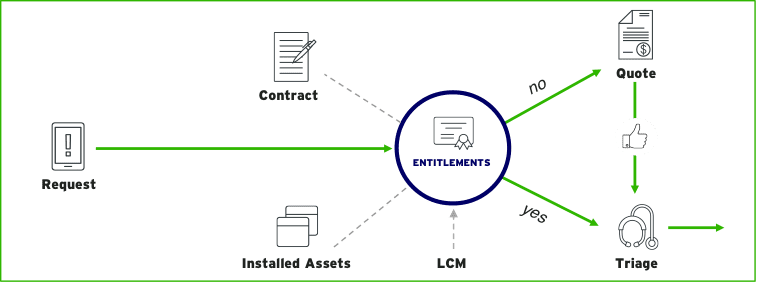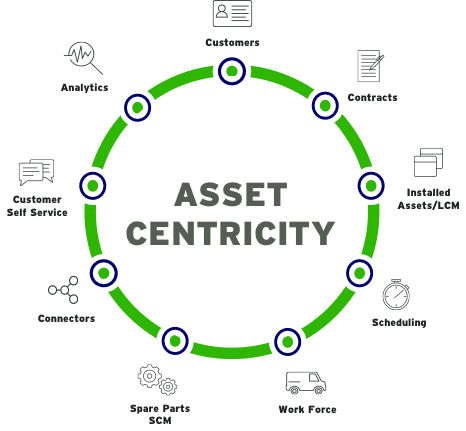When you call up your garage/mechanic to schedule service on your car, what is the first question they ask? Do they ask your name, or do they ask your license plate number to identify make and model? This is at the core of asset centricity. While the customer record is important, it is knowledge of the asset that is essential for service resolution. The asset, as tracked throughout its life cycle, is the central piece of a service organization’s attempts to drive cost efficiency, revenue generation, and customer satisfaction.
1. Know Your Installed Base
As part of the process followed by the Global Customer Transformation team (GCT), we often get called to assess the maturity of the service business of a customer or prospect. One of the first questions we ask any organization is what level of visibility they have on their installed base. Do you track your products/equipment assets beyond point-of-sale?
The rationale is simple. If you want to be efficient in service delivery, you need to know where your assets are and in what state. If you want to drive revenue and satisfaction, you need to know how your customers are using the assets and why those assets are important to them in their operations. Without knowledge of your installed base, your actions will be ad hoc and at the mercy of technician tribal knowledge.
When Schneider Electric transformed their business model from ‘sell and forget” to “sell and service,” they were able to grow their installed base visibility from 10% to 35%, driving service revenue by 11% YoY.
2. Recognize the Asset
You may know the customer, but if you don’t know the asset you may make the wrong decision. This is illustrated in the entitlement process. Entitlement is the gateway to cost control, revenue increase, and customer satisfaction.
- Leakage: provide service on an asset without warranty and/or contract
- SLA attainment & CX: over/underdeliver on customer expectation
- Attach rates & revenue: miss an opportunity to cross and upsell

Often, we hear organizations say that their knowledge about their assets is not yet at a level to perform a reliable entitlement process, resulting in a lot of corrective actions post-work order debrief. Have a look at the Schneider Electric video—collecting and validating asset data is a journey.
Tip: If the ‘saved’ time from improving technician productivity does not constitute an extra job per day, you can use the time to take inventory of the installed assets and document their state and surroundings.
3. Know the Asset
You might know the technical details of the assets you produce. Your maintenance manuals may prescribe what to do under nominal operating parameters. But what do you know about how your customers are using the assets? Some may be ‘sweated’ and run at 99% of capacity. Others may only be used occasionally.
Knowing how your assets are being used by your customers is an essential piece of information to define the right action. It will put the service request in context, help in the entitlement decision, and support the triage process. It will give your customers the feeling that you’re providing contextual solutions.
4. Manage the Asset
In the car example of the opening paragraph, the mechanic focuses on the asset. The asset has a life cycle and in each phase of the life cycle different service and maintenance activities need to be executed.
The car may be purchased/leased by owner A. After a number of years, the asset may transfer to owner B. If the maintenance history would be tied to the customer record, the data would be lost under ownership B. This is why more and more organizations are adopting asset centricity for life cycle continuity.
This continuity is extremely important in regulated industries. If any time in the life cycle a quality or compliance defect is detected in a series of assets, then you would like to have the opportunity to search an asset-centric installed based, instead of sending messages to the owner who did the initial purchase of the asset.
Why Prioritize Asset Centricity?
Asset centricity allows you to effectively manage your field change orders and mid-life upgrades. Asset centricity is an equally as powerful paradigm as customer centricity. Try to merge them into your business operations. Consider the impact of this asset centricity on your sales and supply chain business functions. Would they like to know the state of your installed base and which areas are ripe for replacement or upgrades?
Interesting in Learning More About Achieving Asset Centricity?
We are on a journey to educate service organizations about the value of asset centricity and an Asset 360™ approach to service and business transformation. On April 21 & 22, ServiceMax CMO & CXO, Stacey Epstein held virtual keynote sessions to introduce Asset 360™: The Foundation for the Future of Field Service Management. During the Keynote, Stacey discussed how service organizations can increase uptime, reduce costs, and maintain compliance through an asset-centric approach. Topics included:
- Best practices to meet changing business requirements
- The unique needs of asset-centric businesses
- How technology enables an Asset 360™ approach
Watch the on-demand replay here.



Share this: